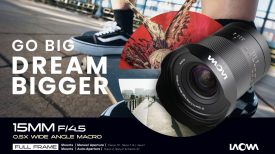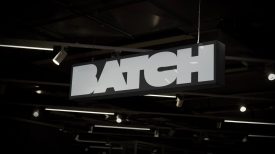By technical editor Matt Allard:
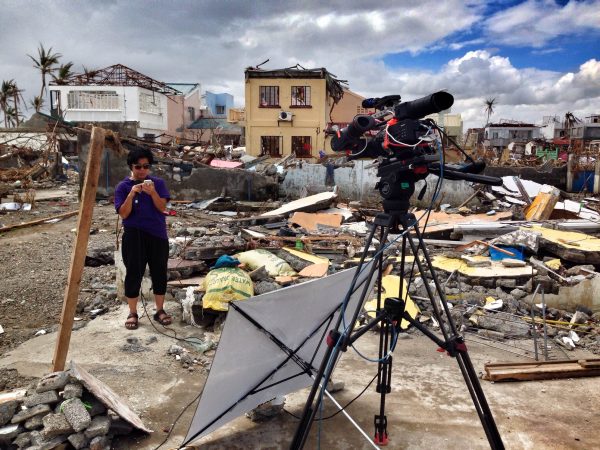
Covering natural disasters is one of the hardest assignments. There are so many variables to deal with, including the logistics of getting in and out. When Typhoon Haiyan hit the southern part of the Philippines, Aljazeera English as well as Aljazeera America sent in multiple crews. Our Philippines bureau crew were already in Tacloban City when the storm hit.
They were staying in a hotel close to the water when the storm surge came in and they were pinned up against the ceiling of their hotel by raging waters and almost lost their lives. It shows how dangerous this job can be.
Haiyan was one of the biggest “Super Storms” to ever be recorded; Hurricane Katrina, which devastated New Orleans, paled in size in comparison. With winds over 200mph, the typhoon hammered into the Philippine coastline bringing with it a severe storm surge that resembled a tsunami. Waves of five metres or higher washed inland in some spots, taking lives and destroying property. Many people died because the term “storm surge” was too vague for most Filipinos to understand. Experts agree that if they had used the word tsunami – not technically the right term – then more lives could have been saved.
Typhoon Haiyan from Matthew Allard on Vimeo.
Just getting to the disaster areas is not that easy. You can’t simply get on board a plane and land at the airport where you need to be. Many airports in the effected areas were closed for up to eight days after the storm hit. When the airports do start to reopen, they are for non-commercial aircrafts only; aid and help need to be the priority.
There is always a moral dilemma when trying to get into a disaster zone. Do you take up space on an aid plane to get there? Or do you find another way? Sometimes an aid plane may be the only way in. While you are taking up valuable space and cargo that could have been replaced with aid the media does need to be there. I might get heavily criticised for saying this, but the media has an important role to play in disaster zones. Without reports and pictures coming out the rest of the world doesn’t know what is happening. It helps get more aid sent in and that’s why NGOs and officials want us there. It also keeps governments, who may not be doing a great job with the recovery, honest. Would I prefer to get in on some other way? Absolutely, and most Aljazeera crews got in on private chartered helicopters. But sometimes there is no other choice.
Having covered a lot of natural disasters over the years, I have a pretty good idea of exactly what I need to take with me. You always have to think about the worst case scenario. It is very important to communicate with people who are already on the ground, finding out as much as possible, such as what the conditions are like, what is available and how long you may have to be there. So I knew from other crews that there was no food, no water, no electricity and no accommodation.
You have to pack light, but you also have to take everything you need. You cannot count on being able to get anything once there – and with survivors in dire need of food, water and basic supplies, you should try not to add to the demand. You have to be quite ruthless with your decisions about what to take and what to leave behind. You may face weight restrictions on planes, boats, helicopters and other vehicles. You also need to be able to carry the equipment yourself and you may very well not be able to leave anything anywhere. In extreme circumstances people do desperate things. Looting happened in the early days of the disaster and many people who had lost everything took whatever they could find. Being able to look after and protect your equipment and the gear you need to survive is paramount. If these items get taken, you have not only lost your capability to work, but have put your crew’s lives in danger.
To non-news folks it sounds strange then to worry about technical issues in this situation, but we are there to show people what has happened and it is important to do that as effectively as we can.
I took the Sony FS700 because this camera is small, compact, battery and memory efficient. I could use the Sony E PZ 18-200mm f3.5-6.3 power zoom. This enabled me to not have to change lenses and also gave me the ability to zoom in and out which is super important when doing live crosses to show your environment.
I may get condemned for saying this too, but the auto focus function coupled with the steady shot was perfect for this job. I was able to zoom into the distance and keep perfect focus at all times. When I came back onto my correspondent, face tracking would pick her up instantly and transition focus. The FS700 still gave me the super 35mm look, high dynamic range and great low light ability that no broadcast camera could achieve.
I could have taken a traditional broadcast camera but they are heavy, use large batteries and require a large battery charger. Mine uses a disc based media which would take more space that I didn’t have. I didn’t have to change my SD card on the FS700 for the whole trip. The FS700 also gave me the ability to do live crosses through Quicklink and a BGAN (mobile satellite uplink terminal). I packed two other lenses just in case. A Sony G 70-400mm f4-5.6 and a Sony Zeiss 24-70mm f2.8. I only used the 24-70 once, and I didn’t even pull out the 70-400mm.
I took about seven Sony batteries that not only powered my camera but also my small LED lights. I took a Cineroid LED, a cheap Chinese-made LED and a Westcott Ice light. I had a RODE NTG3, a RODE reporter mic and a Sennheiser radio mic set. I packed the BGAN, cables associated with it, a Macbook Pro and a satellite phone. The satellite phone is so important. In a lot of disaster zones, there may be no cell phone coverage so you may have zero communications. If you can’t communicate with the outside world you are in trouble. I also packed a Cine saddle. My Sachtler 20P tripod, a couple of light stands, diffusers in frames (which can be broken down) and the fabulous Nori square bounce went into my tripod bag. That was pretty much it as far as equipment went apart from a Gopro and a NEX5 as back up camera.
Power is a huge issue when covering a disaster. Without power you can’t charge equipment or send any stories back. It is crucial you find a generator and fuel. This can be easier said than done.
For survival I packed two bags. This is where you don’t compromise because without shelter, food and water you won’t survive long. The Philippines is very, very hot and extremely humid. The average person needs 4-6 litres of water a day in conditions like this. Just think about that for a second – if you have three people you need to look after that is 18 litres of water a day. I packed a tent, three sleeping bags, a water purifier (essential item), mosquito nets, torches, spare batteries, insect repellent and first aid kits, wet weather jacket and camera cover. I had another bag packed entirely with food and water: muesli bars, biscuits, MRE (military ration packs that can be heated up in a special bag with a small amount of water) and some chocolate bars – all items that provided energy and that were light and easy to pack. I packed about 18 litres of water as a backup supply because I knew I’d be able to get more on the way to the disaster. So my final kit was 5 check-in bags (two were survival and food) and two carry on.
I flew into Cebu, the nearest regularly working airport to the disaster zone, and the following morning myself, Veronica Pedrosa (correspondent) and Ricky (security) lined up for tickets for a 5.30am ferry to a town called Ormoc. There were massive lines and we didn’t get on to a ferry until 11am. The ride was about three and a half hours and we arrived at a chaotic pier with people everywhere and a devastated city. Only half my bags could be put on the ferry as it was so full. The other bags came on a later ferry. It is a very uneasy feeling knowing that your survival equipment is not in your possession and just hoping it turns up. A hundred per cent of Ormoc city was affected in some way, but it was not nearly as badly damaged as Tacloban.
Ormok from Matthew Allard on Vimeo.
We spent two night staying in Ormoc in a destroyed hotel that kindly gave us shelter and on the second day a generator and fuel came across on another ferry from Cebu for us to use. Luckily there were still two fuel stations open, with really long lines, so we were able to secure more fuel. We also secured as much water as we could physically take as I knew it was going to have to last for a week.
Ormok Day 2 from Matthew Allard on Vimeo.
From Ormoc we shared a van with other people trying to get to Tacloban. It was a three hour journey across the mountains, where we saw an endless path of devastation: hundreds of kilometres of flattened trees and houses. Despite reports of looting and violence we found many people lining up in an orderly fashion waiting for relief to be handed out.
In Tacloban and the surrounding areas we saw the worst of the devastation. On the way into the city there was a body still at the bus stop under a sign that said “We Love Tacloban”.
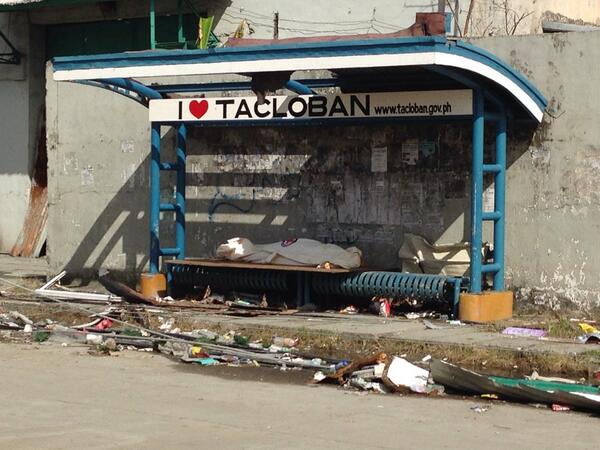
The first night we spent sleeping in the back of a crowded van. My generator was playing up because of dirty fuel and was stalling about every three minutes. I needed to transmit/send/FTP my story so I was sitting next to the generator for three hours hand-pumping fuel into it every 30 seconds. The rest of the time we bunked down on the floor of a destroyed church just outside of town.
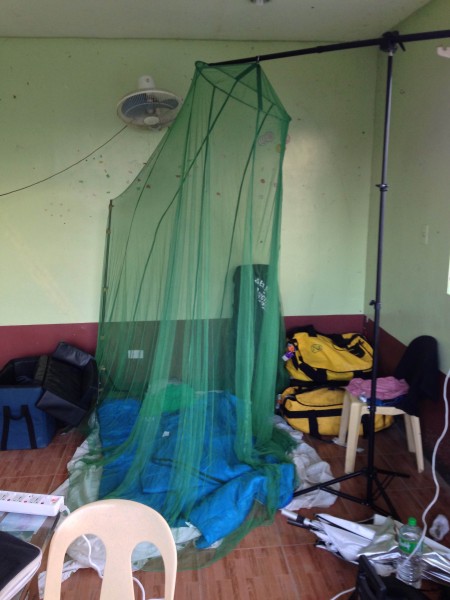
I was able to run the generator and power the phones of desperate people who were trying to get in contact with loved ones. At one stage there were more than 200 people charging their phones with a snaking line of power board after power board running down the street. It felt good that I was able to do something for these people, no matter how small.
Tacloban City from Matthew Allard on Vimeo.
During the day we would do live crosses, then set out to news gather and produce a package. At night we would be editing, charging and sending the stories back. That became a daily routine. It is emotionally and physically exhausting work. The smiles and the warmth of the people I encountered got me by.
My more than eight days in disaster-struck Philippines were gruelling. No sanitation, no proper place to rest, surviving on MRE ration packs, and working throughout day and night. But this was nothing compared to what the residents were going through. Witnessing their reality gave me a real sense of just how lucky we are. I got to leave eventually. The people in the Philippines have no choice but to stay on and to face the long, hard way ahead to rebuilding their lives.
If you would like to donate to the disaster relief then I recommend Medecins Sans Frontieres who do great work in these extreme conditions.
About Matthew Allard, Aljazeera Team Leader Cameras, Kuala Lumpur:
Matt has been a Camera/Editor in TV news for more 22 years, previously working for both Channel 9 and Channel 10 in Australia. Twice Network Ten Australia’s cameraman of the year as well as being a Walkley Finalist for outstanding camerawork in 2006 (for coverage of the Cronulla Race Riots) and a Logie Finalist for outstanding news coverage 2006 (Bali 9). He has won 14 ACS (Australian Cinematographers Society) awards. His Sword Maker story that was shot on a 7D won the prestigious Neil Davis International News Golden Tripod at the 2011 ACS Awards. He has covered news events in more than 35 countries, from major sporting events to terrorist bombings. Based out of the Kuala Lumpur broadcast centre in Malaysia he is an avid user and follower of new technology, shooting stories on HD broadcast cameras, the Sony FS700 and F3 as well as Canon DSLRs.




